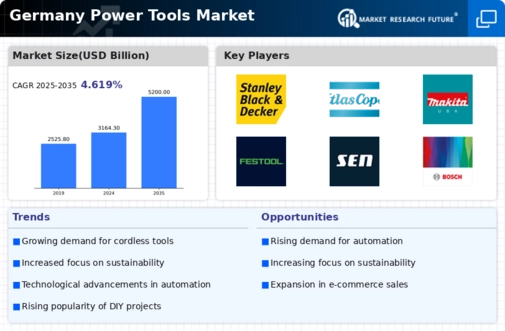The Germany Power Tools Market is characterized by a diverse and rapidly evolving competitive landscape driven by innovation, technological advancements, and changing consumer preferences. Various players operate in this market, ranging from established industry giants to emerging local manufacturers. Competitive insights reveal a strong focus on product differentiation, customer service excellence, and robust distribution networks among key market participants. The competition in the power tools sector is largely influenced by trends like the growing demand for cordless tools, increasing adoption of automation, and sustainability considerations.
Companies are investing in research and development to introduce new features, enhance efficiency, and improve user experience, positioning themselves strategically to capture greater market share.Stanley Black and Decker holds a significant position in the Germany Power Tools Market, showcasing its strengths through an extensive portfolio of high-quality tools and equipment tailored to both professional and DIY users. The company's commitment to innovation is evident in its ongoing product development efforts, particularly in the cordless and battery-operated segments, catering to the increasing preference for portable solutions.
Stanley Black and Decker benefits from a well-established brand reputation and a robust distribution network, enabling it to reach a wide customer base across Germany. The company has also focused on building strong relationships with retailers and distributors, enhancing its market presence and customer accessibility. By leveraging its expertise and commitment to sustainability, Stanley Black and Decker aims to address the evolving needs of the German market.Atlas Copco, another prominent player in the Germany Power Tools Market, emphasizes its strength in providing professional-grade tools and solutions for industrial applications.
Renowned for its high-performance products, Atlas Copco specializes in air-powered tools, which are widely used in manufacturing and assembly industries in Germany.
The company is recognized for its commitment to innovation, which is evident in its continuous improvement of existing products and the introduction of new technologies that prioritize efficiency and sustainability. Atlas Copco's strong market presence is supported by its extensive service network, ensuring comprehensive support and maintenance for customers. The company has also engaged in strategic mergers and acquisitions to expand its product offerings and market reach, positioning itself as a key player in providing reliable and advanced power tool solutions tailored to the specific needs of German consumers and industries.





















